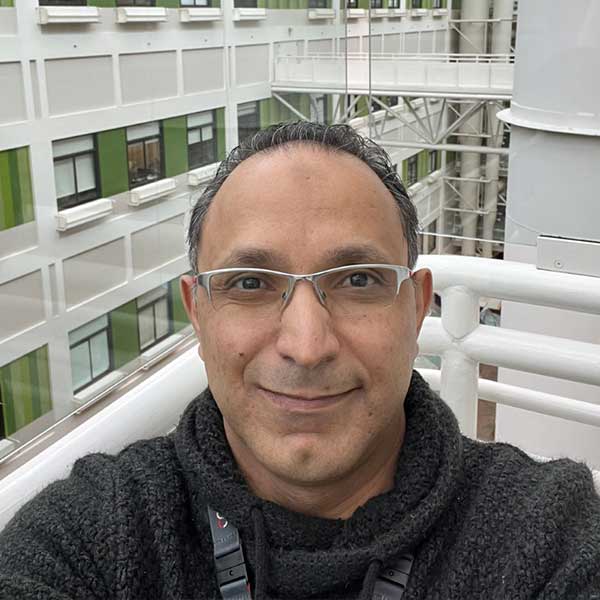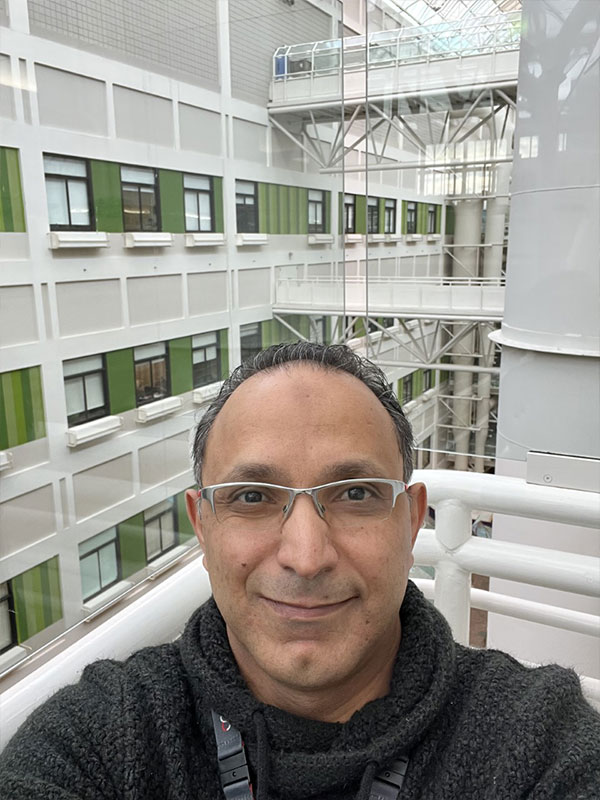BloodTechNet supports educational laboratory rotation for transplant and transfusion ‘matchmakers’

Each year, Canadian Blood Services’ BloodTechNet award program supports innovative educational projects within the transfusion, cellular therapy and transplantation communities that can deliver educational tools and resources to health professionals in Canada. One successful project aimed to facilitate laboratory rotations for directors in-training of histocompatibility and immunogenetics laboratories whose highly specialized expertise in human leukocyte antigen (HLA) testing supports transplant and platelet transfusion activities throughout Canada.
Collaborators on the project included members of the National Human Leukocyte Antigen Advisory Committee (NHLAAC) led by Canadian Blood Services. The NHLAAC engages HLA directors and transplant specialists to improve and standardize laboratory practices in support of organ and tissue donation and transplantation in Canada. When this project application was successfully accepted by the BloodTechNet award program, a special travel bursary called the “NHLAAC Rotation Program – Travel Bursary” was established to support participants to complete a rotation.
To highlight the impact of this innovative Travel Bursary, I spoke with three colleagues who each have their own unique connection to this educational project.
Eric Wagner: As an HLA laboratory director based at CHU de Québec-Université Laval in Québec City and chair of the NHLAAC, Eric is the lead on the BloodTechNet project that established the NHLAAC Rotation Program – Travel Bursary.
Fatima Dharsee: A senior program manager of deceased donation, interprovincial organ sharing and transplantation at Canadian Blood Services, Fatima is one of the collaborators on the BloodTechNet project and manages the NHLAAC.
Ahmad Abu-Khader: As a histocompatibility and immunogenetics fellow at Alberta Precision Laboratories in Calgary, Ahmad is the first recipient of the NHLAAC Rotation Program – Travel Bursary and completed his 4-week-long rotation in Edmonton in January 2022. Ahmad is no stranger to Canadian Blood Services – he completed a postdoctoral fellowship with Canadian Blood Services in Dr. Nicolas Pineault’s laboratory between 2014-2016.
HLA and the role of a lab director
Histocompatibility and immunogenetics laboratories in Canada make crucial contributions to the process of connecting patients with donated organs, tissues, stem cells and platelets. There are 16 histocompatibility and immunogenetics laboratories located across Canada but not every lab encounters the same type of transplant and transfusion testing on a daily basis. Some lab locations focus on certain types of cases, depending on their local needs and laboratory size.
These laboratories are supervised by individuals called HLA lab directors. In a way, HLA lab directors act as matchmakers. When a request from a hospital or clinic is received, they set to work scrutinizing samples from the patient and potential donor to compare compatibility and analyze antibodies in pursuit of connecting the best donor-patient pairings.
It’s important to note that an HLA lab director’s work isn’t over when a match is made. Even after a transplant or platelet transfusion has occurred, HLA lab directors are involved in evaluating the risk of rejection and understanding factors around disease associations and adverse reactions. They provide consultation directly to physicians and health-care teams to support the goal of successful patient outcomes.
What is HLA, and why is it important for patient-donor matches?
-
Fatima: Human leukocyte antigen (HLA) is found on the surfaces of red and white blood cells. HLA is what gives your immune system its own unique imprint and when a transplant is required, HLA lab directors use their training, procedures, and technology to understand the unique imprints of each patient and donor in order to identify the best match.
Who might need the services of a histocompatibility and immunogenetics lab?
- Eric: Histocompatibility and immunogenetics labs complete testing for patients awaiting organ and stem cell transplants, and they evaluate the potential of organ and stem cell donors. Anyone currently on the list for a transplant, as well as potential donors and those who have received transplants would need the services of one of these labs for testing.
- Ahmad: At the lab, we can also do typing for blood bankers so they can find the best platelets to use when a patient needs a transfusion. Proper typing makes sure the platelets can do what they need to do for the patient because without it, their body would destroy the donor’s platelets.
Why are rotations to different labs helpful for directors in-training?
- Eric: Collaboration on this project submission included 8 other HLA lab directors across Canada because we recognized a need for lab directors in-training to be exposed to different areas of expertise. The intent was to allow directors in-training to be exposed to other labs in a way that helps build the experience and knowledge base they can draw on at their home lab. This includes knowledge and familiarity around new techniques, technologies, and/or transplant types.
- Fatima: The goal, very simply, is to equip the next generation of HLA lab directors in Canada with the most up to date knowledge. It focuses on ensuring that those involved in the testing are trained on a broader range of cases, which may help them analyze difficult aspects of specific cases in the future.
- Ahmad: My role as a histocompatibility and immunogenetics fellow, or director in-training, is to learn about how the process goes from getting the samples, to completing the typing, to giving reports to the clinical team that is treating the patient. At my lab in Calgary, I usually see requests associated with organs like pancreas or kidneys, so completing this rotation in the Edmonton lab with the support of the Travel Bursary was a way to familiarize myself with the processes and techniques used for other solid organs.
What does a rotation involve?
- Eric: Each applicant develops their own set of learning objectives for the rotation. This can influence what lab location they choose to complete their rotation at as well as what they focus on while there. Maybe they learn a new assay, learn about a different type of transplant, or maybe they are exposed to a specific technology that their home lab does not have. Because of the complexity of the learning, the rotation would typically take place over a few weeks.
- Fatima: During the rotation, they are training under another lab director that has a vast amount of experience. Of course, the cases that are being looked at might vary depending on the requests that come through during that specific timeframe, but primarily a rotation offers the opportunity to learn from the knowledge and experience of the hosting lab director and their team.

Ahmad Abu-Khader visiting University of Alberta Hospital in Edmonton during his HLA rotation, 2022.
Building experience for lab directors of the future
Ahmad is quick to acknowledge those involved in making his rotation experience possible. In correspondence following his rotation, Ahmad noted appreciation for the “wonderful and fruitful training” that “opened my eyes to new solid organ transplant testing, procedures, and troubleshooting.”
As the first participant in this rotation, what was the experience like?
-
Ahmad: I completed my rotation at the Edmonton laboratory with the director, Dr. Trish Campbell. The Edmonton lab is located at the University of Alberta hospital where Dr. Campbell is also a professor in the department of laboratory medicine & pathology. My rotation was four weeks long. I spent time shadowing Dr. Campbell and discussing cases, including the difficult aspects of specific cases and the tricks for troubleshooting. I also worked with a technologist to learn about technical decisions, like how they test and what they test for with each case.
What was the most impactful learning from your time in the rotation and how will this support your future work?
-
Ahmad: In this rotation, I got to see a different perspective on the testing that’s completed and learned about what is acceptable for different targets. The rotation allowed me to see the differences in terms of clinical applications specific to the type of transplant like, for example, when a liver is needed it may be able to be taken from a donor who is very slightly mismatched, but that’s not the case with bone marrow. The rotation hasn’t necessarily changed my day-to-day work, because back in my lab in Calgary I have returned to the types [of organs] we typically focus on there. But this has provided more knowledge base that I could draw on when I am finished my fellowship.
To learn more about the BloodTechNet award program, visit our research funding opportunities webpage: Canadian Blood Services BloodTechNet Award Program.
To see the resources created by past BloodTechNet funded projects, visit our BloodTechNet educational resources page on ProfEdu.ca.
For information about HLA/HPA selected platelets, including how to order testing, visit HLA/HPA selected platelets.
Canadian Blood Services – Driving world-class innovation
Through discovery, development and applied research, Canadian Blood Services drives world-class innovation in blood transfusion, cellular therapy and transplantation—bringing clarity and insight to an increasingly complex healthcare future. Our dedicated research team and extended network of partners engage in exploratory and applied research to create new knowledge, inform and enhance best practices, contribute to the development of new services and technologies, and build capacity through training and collaboration. Find out more about our research impact.
The opinions reflected in this post are those of the author and do not necessarily reflect the opinions of Canadian Blood Services nor do they reflect the views of Health Canada or any other funding agency.